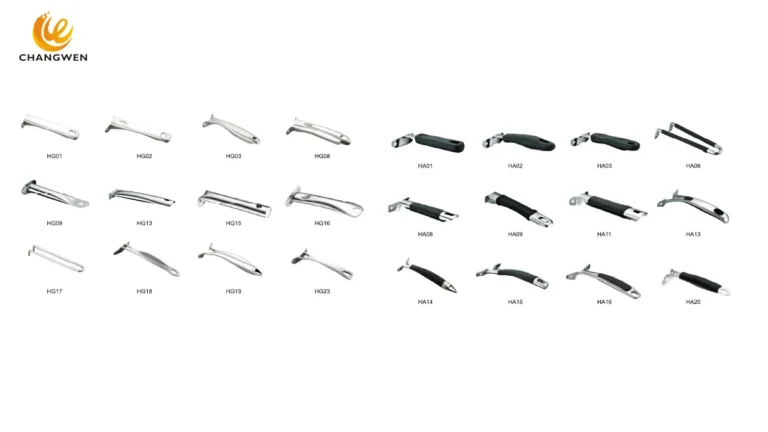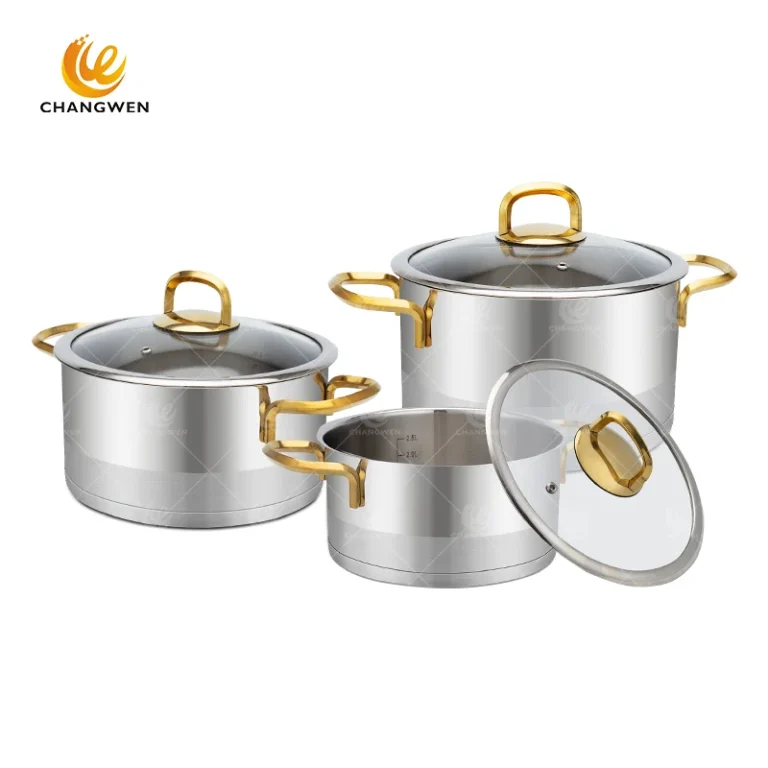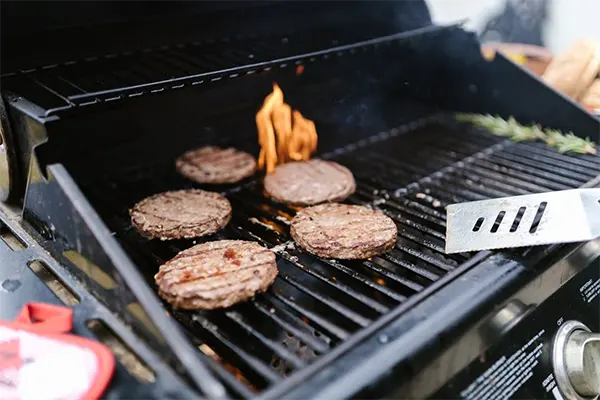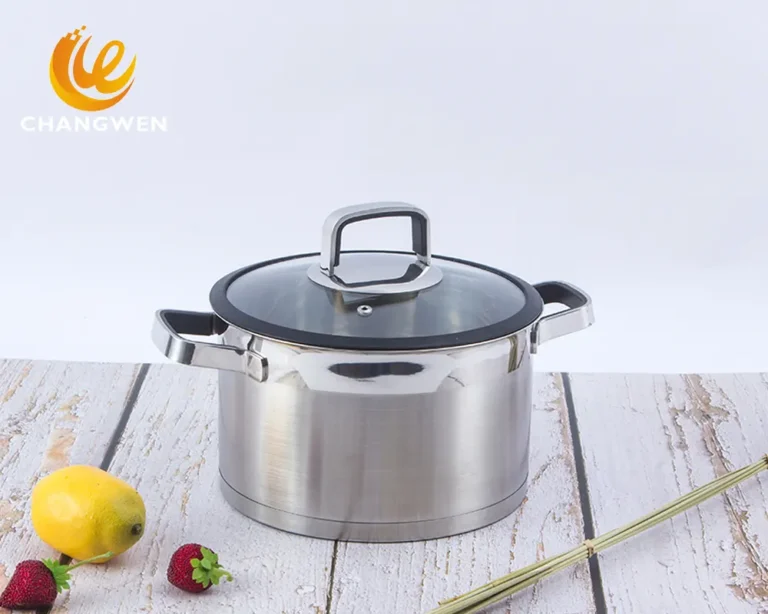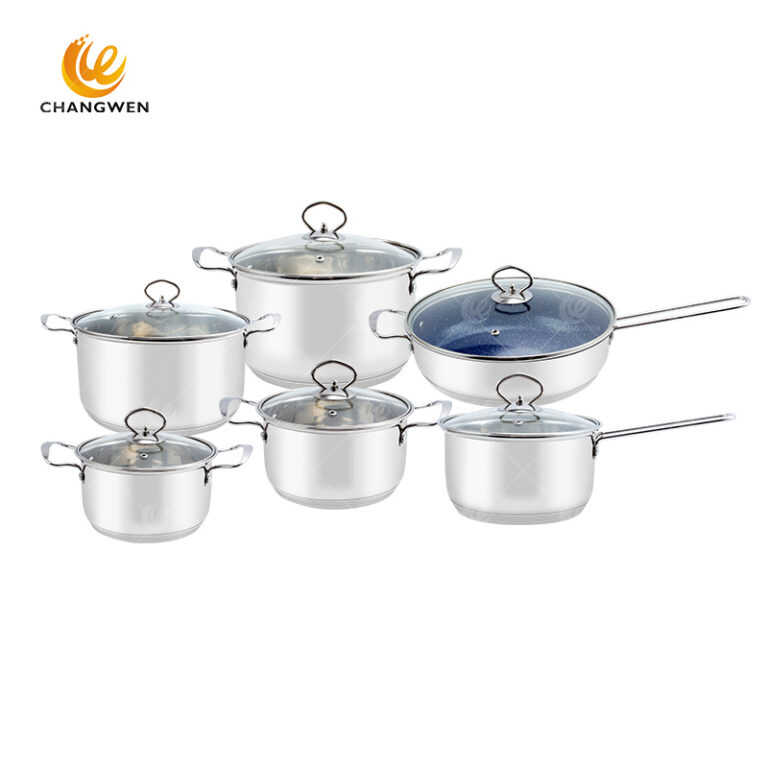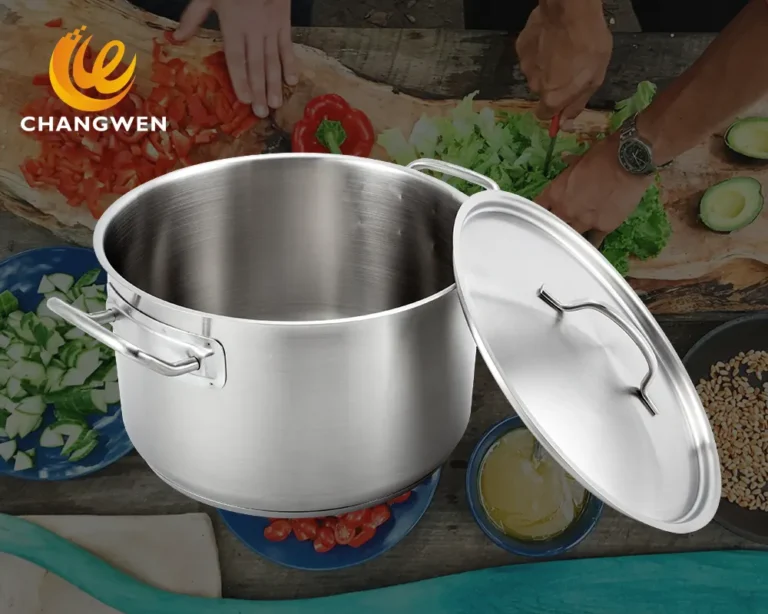What’s The Difference Between Pots And Pans: Appearance, Material & Uses
There are many types of cooking utensils, with different shapes, sizes and materials. But generally speaking, they are divided into two categories, namely pot and pan.
Pot is mainly used for boiling food, such as boiling, heating milk, cooking jam, cooking noodles, etc. Pan is mainly used for frying food, such as frying steak, frying chicken, frying fish, frying eggs, etc. Frying is generally suitable for small amounts of food, while pots can cook more food.
We will conduct an in-depth analysis of pots and pans to understand the appearance, functions and uses of different pots and pans.
Table of Contents
What Is the Difference Between a Pot and a Pan?
We’ll introduce 5 different pots and pans below: saucepans, sauciers, saute pans, sauce pots, and stock pots. Even though these names sound very similar, each piece of cookware has a different use.
Appearance
Pots:
Typically feature deep, tall sides.
Come in various shapes but are generally more cylindrical.
Usually have two small handles on opposite sides.
Pans:
Typically have shallow, wide sides, great for flipping and turning food.
Are often round but can come in square or rectangular shapes as well.
Usually equipped with one long handle and occasionally a smaller helper handle.
Stock Pot And Soup Pot

A stock pot or soup pot is a large, deep pot that is particularly designed for making stocks, soups, stews, and boiling pasta. It is typically made from materials like stainless steel, aluminum, or enamel-coated cast iron and features a flat bottom that helps in the even distribution of heat. With its tall sides, the stock pot is ideal for cooking large quantities of food and is a staple in many kitchens for its versatility and utility in a range of cooking tasks from simmering to boiling. The stock pot is larger than the soup pot. The size of the stock pot ranges from about 6 quarts to 20 quarts, etc., and the size of the soup pot ranges from about 4 quarts to 12 quarts.
A stock pot is larger than a soup pot. Stock pots range in size from about 6 quarts to 20 quarts, while soup pots range in size from about 4 quarts to 12 quarts.
Stainless steel soup pot
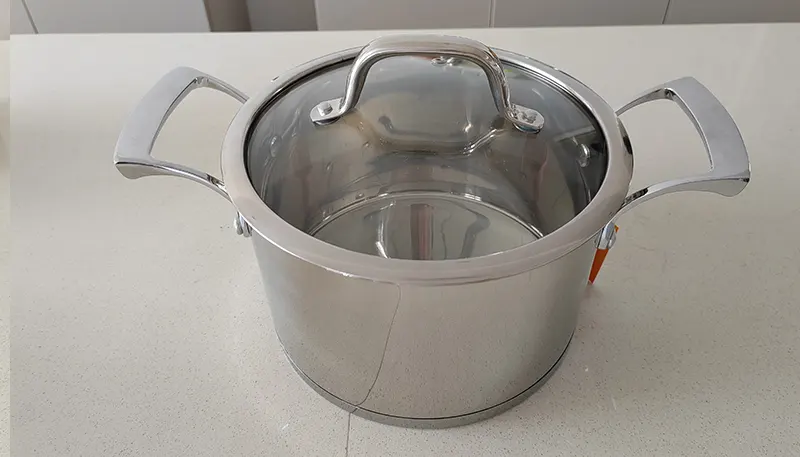
Bright appearance, clean and hygienic, wear-resistant and light, easy to wash and disinfect, stable chemical properties, acid-resistant, alkali-resistant, corrosion-resistant.
Ceramic soup pot
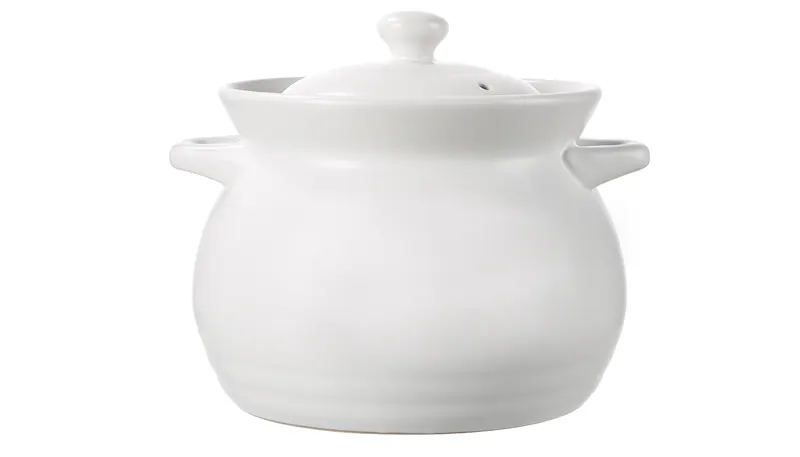
A soup pot made of ceramic, with the characteristics of beauty, heat resistance, corrosion resistance, and easy cleaning. Ceramic soup pots are relatively heavy and not so convenient to move. Ceramic soup pots are beautiful and generous, but they are also easy to break.
Enamel Cast iron soup pot

A soup pot made of cast iron, with the advantages of uniform heat transfer, corrosion resistance, and long service life. Cast iron soup pots are relatively heavy and not very convenient to move. It is necessary to consider whether the place where it is stored and used is convenient to move.
Glass soup pot

A soup pot with high transparency, fast heating, and easy to clean. Glass soup pots generally have multiple functions, such as boiling, stewing, steaming, etc. Glass soup pots are transparent, which is convenient for observing the cooking process of food, but they are also relatively fragile.
Frying pan
Frying pans are usually used for cooking methods such as frying, stir-frying, and baking. Common manufacturing materials include cast iron, stainless steel, aluminum, etc. The bottom of the frying pan is usually flat or slightly raised to facilitate even heating of food. Frying pans come in different shapes and sizes, such as round, square, rectangular, etc., with diameters of 20 cm, 30 cm, 40 cm, etc., to meet various cooking needs. They usually have a long handle for easy movement and control of the cooking process. Frying pans are one of the basic cooking utensils commonly found in the kitchen and are used to make a variety of dishes, such as fried rice, fried eggs, barbecue, etc.
Stainless steel frying pans
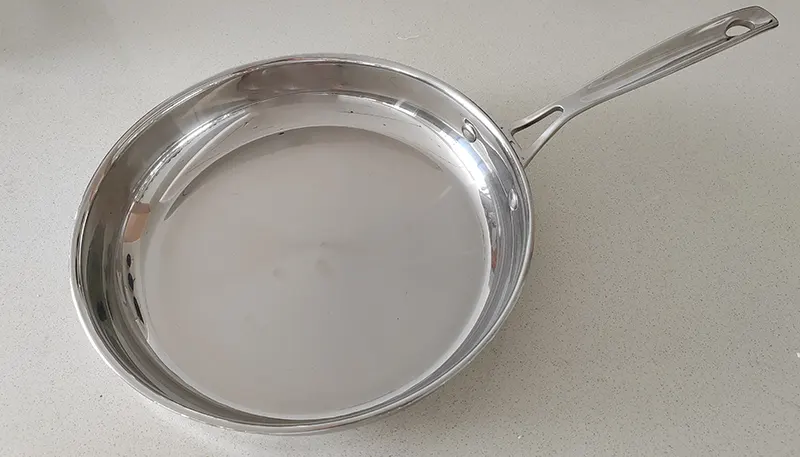
Stainless steel frying pans have excellent corrosion resistance and aesthetics, and are easy to clean and not easy to deform. Its thermal conductivity is poor, and it takes a long time to reach the appropriate cooking temperature. Commonly used materials are 304 stainless steel and 316 stainless steel.
Cast iron frying pans

Cast iron frying pans are called cast iron skillets. Cast iron skille has good thermal conductivity and heat preservation, and can cook delicious food in a short time. But it needs to be maintained after use to prevent rust. Cast iron frying pans are ideal for frying steaks. Cast iron frying pans are particularly suitable for open flame heating and can reach very high temperatures. In this way, when frying steaks, the Maillard reaction is more complete, making the steak crispy on the outside and tender on the inside, with a unique pan flavor.
Non-stick frying pans
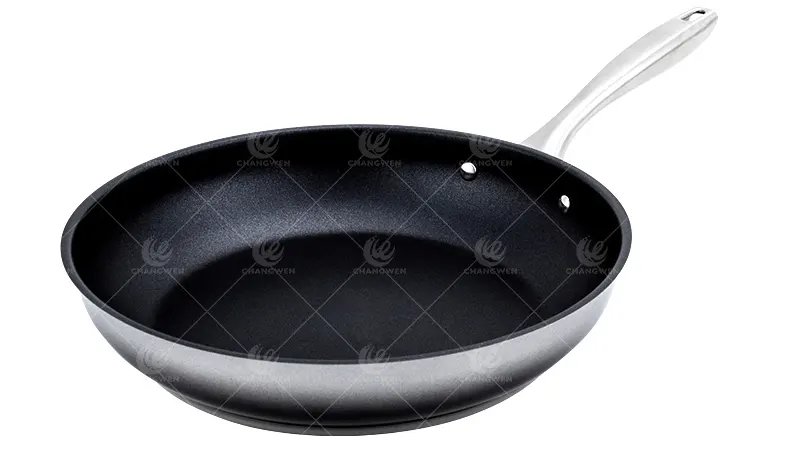
Non-stick frying pans are not easy to stick to the pan when frying and baking food. They are easy to clean and can minimize the use of oil and help reduce fat intake. The most common non-stick pans on the market are mainly divided into two categories, namely Teflon (PTFE) coating and ceramic coating. Teflon, scientific name polytetrafluoroethylene, abbreviated as PTFE. It is a polymer compound formed by the polymerization of tetrafluoroethylene, with excellent chemical stability and corrosion resistance. It can work for a long time at temperatures of +250℃ to -180℃). Therefore, this material is the most commonly used non-stick pan on the market. Ceramic non-stick pans are also safe, do not contain PTFE and PFOA, and are resistant to high temperatures up to 450℃. Even if the temperature exceeds 450℃, no harmful smoke will be produced. Although the high temperature range of ceramic coating exceeds that of Teflon, 250℃ is enough for daily cooking, and the price of Teflon coating is cheaper than that of ceramic coating.
Aluminum frying pan

The characteristics of aluminum frying pan are good thermal conductivity, light material, and low price. However, aluminum is not good for health after being ingested by the human body.
Saucepan
A saucepan is a round, flat-bottomed pan with tall, straight sides and a long handle, designed primarily for cooking over a stove. It’s an essential piece of cookware mostly used for preparing liquids, such as soups, sauces, boiling pasta or vegetables, and even making grains like rice. Saucepans have a wide range of sizes, but they are typically deeper than they are wide to accommodate a good volume of content without taking up too much space on the stove. They usually come with a tight-fitting lid to facilitate faster cooking and to help retain moisture and heat. The materials used for saucepans include but are not limited to stainless steel, aluminum, and non-stick coatings, each offering different advantages for various cooking methods and preferences
Stainless Steel Saucepan
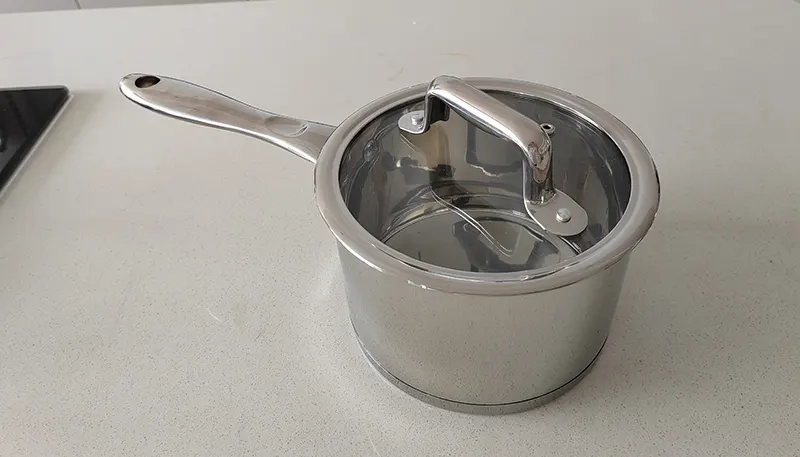
Stainless steel Saucepan has healthy and no coating, stable chemical properties, good strength and plasticity, and relatively stable mechanical properties at certain high or low temperatures. Easy to clean, strong durability and other advantages.
Maifan Stone Material Saucepan
Maifan Stone pot is an aluminum alloy pot with a special coating that can be used directly on an open flame. The Maifan stone pot is not a pot made of natural materials. It is added with mineral particles. The entire pot body is cast in one go. Because it has a high temperature resistant layer and non-stick coating, it is not easy to stick to the pot. It is very healthy to use this pot to cook noodles. It is not heavy and is light and convenient to hold.
Cast Iron Saucepan

The cast iron pot is made of iron melt casting. It is a pot made of natural materials. There is no chemical coating and aluminum products. It is relatively healthier and heats evenly. It is not easy to stick to the pot. The surface is smooth and the temperature inside the pot can be higher.
Transparent Glass Saucepan

The glass Saucepan is made of glass material. It is an integrated pot with no coating or heavy metal material on the surface, so it is safe, healthy and reliable to use. The glass Saucepan is transparent, and you can directly see the changes in the heating process of food from the outside. Glass conducts heat quickly and saves gas during use.
Sauté Pan
A sauté pan is a type of cooking pan used primarily for sautéing, which is a method of cooking food quickly in a small amount of oil or fat over relatively high heat. The word “sauté” comes from the French word for jump, referring to how food might be tossed in the pan. What distinguishes a sauté pan from other types of pans are its wide, flat bottom and tall, straight sides. These features make it excellent for tasks such as browning meat, deep frying, and preparing sauces or dishes with liquid content without spilling.
Stainless steel sauté pan
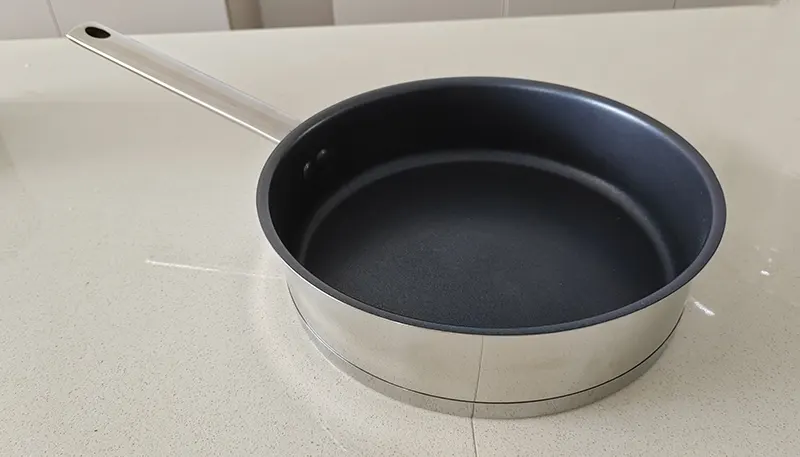
Stainless steel frying pans are extremely durable and resist scratching, denting, and rusting. They do not react with acidic foods, so they can be used to cook a variety of dishes without changing the taste of the food.
Aluminum sauté pan

Aluminum is an excellent conductor of heat, which means it heats quickly and evenly. Aluminum sauté pans have a non-stick coating that needs to be replaced if the coating falls off.
Conclusion
The above is a brief introduction to the names and characteristics of common pots and pans. Different types of pots and pans have different characteristics and usage methods. Choosing the right pot for you can help us prepare food more efficiently.

